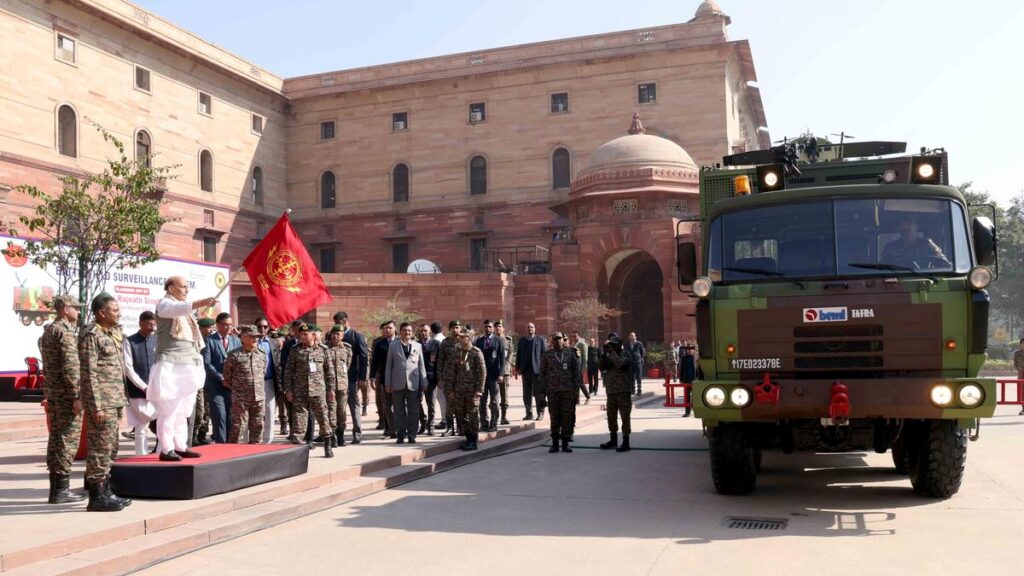
Defence Minister Rajnath Singh flagging off the Battlefield Surveillance System ‘Sanjay’, which will be seen on Kartavya Path on January 26, 2025.
| Photo Credit: PIB
The Defence Research and Development Organisation (DRDO) is set to showcase the indigenous short-range quasi-ballistic missile Pralay at this year’s Republic Day parade. The missile, which is meant for the Army and Air Force, will be the first ballistic missile in India’s missile arsenal meant for conventional strikes. Defence Minister Rajnath Singh on Friday flagged off the Battlefield Surveillance System ‘Sanjay’, which marked the handing over of the system to the Army and will also be see on Kartavya Path on Sunday.
With a range of 400 kilometres, Pralay adds to the BrahMos and Parahar missiles already in the inventory giving the Indian military an option for standoff missile strikes across the border. It is meant for deployment along both the Line of Control (LoC) as well as the Line of Actual Control (LAC).

Development trials of Pralay are over and it is now complete, officials said noting that the Defence Ministry has already accorded the Acceptance of Necessity for its induction. The system features a twin launcher configuration mounted on an Ashok Leyland 12×12 high-mobility vehicle as seen during the ongoing rehearsals for the Republic Day parade.
In 2023, the Defence Acquisition Council (DAC) approved procurement of the Pralay tactical ballistic missiles with a range of 400 km and Nirbhay long-range sub-sonic land attack cruise missiles with a range of 1,000 km, both of which will give a long-range conventional strike option for the Indian military. Put together, a few hundred missiles were approved for procurement by the DAC.
A new derivative of Nirbhay, which has been under development for over a decade now, has been flight-tested recently and trials are underway. Last April, it was tested with an indigenous engine and officials said it is expected to be given to the Army for trials this year.
“The rocket force that is being planned will eventually have all these conventional missiles brought under one umbrella. There are talks for a rocket force that is being looked as a tri-service concept,” one official in the know said.
Pralay, which is a surface-to-surface missile with a range of approximately 400 km and has a capability to strike different types of targets using different types of warheads, noted a Parliamentary Standing Committee tabled last year. The project is under design and development by Research Centre Imarat, Hyderabad of DRDO and is likely to be completed soon, it added.
Pralay was conceptualised in 2015 and flight-tested for the first time in December 2021 with two consecutive tests carried out successfully and conducted on two consecutive days. “The new missile followed the desired quasi-ballistic trajectory and reached the designated target with high degree accuracy, validating the control, guidance and mission algorithms. All the sub-systems performed satisfactorily,” a DRDO newsletter of January 2022 noted.
The missile is powered by a solid-propellant rocket motor with a payload capacity of 500 to 1,000 kg. Stating that the missile’s guidance system includes a state-of-the-art navigation system and integrated avionics, the newsletter said that in its second launch on December 23, 2021, the missile was tested for “heavier payload and different ranges to prove the precision and lethality of the weapon”.
Automated system
Sanjay is an automated system that integrates the inputs from all ground and aerial battlefield sensors, processing them to confirm their veracity, preventing duplication and fusing them to produce a common surveillance picture of the battlefield over secured Army data network and satellite communication network, the Defence Ministry said in a statement. “It will enhance battlefield transparency and transform the future battlefield through a centralised web application, which will provide inputs to Command and Army Headquarters, and the Indian Army decision support system,” it stated.
Sanjay has been indigenously and jointly developed by the Indian Army and Bharat Electronics Limited at a cost of ₹2,402 crore. These systems will be inducted to all operational brigades, divisions and corps of the Army in three phases with effect from March to October this year, according to the Ministry.
Equipped with state-of-the-art sensors and cutting-edge analytics, the battlefield surveillance system will monitor the vast land borders, prevent intrusions, assess situations with unparalleled accuracy and prove to be a force multiplier in intelligence, surveillance and reconnaissance, the Ministry added.
Published – January 24, 2025 10:42 pm IST
Source:https://www.thehindu.com/news/national/pralay-indias-first-ballistic-missile-for-conventional-strikes-to-be-showcased-at-republic-day-parade/article69136778.ece

